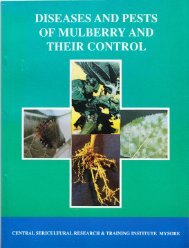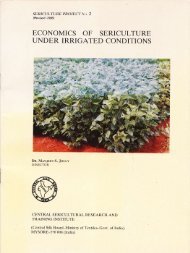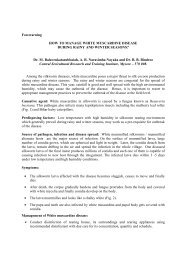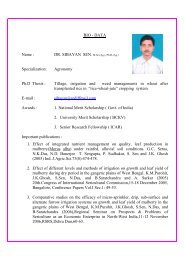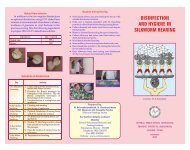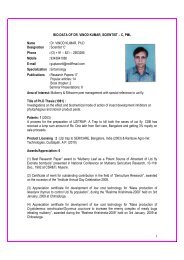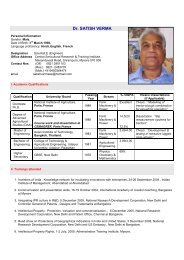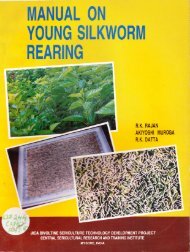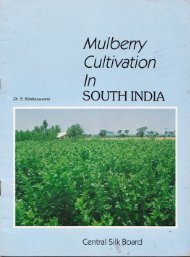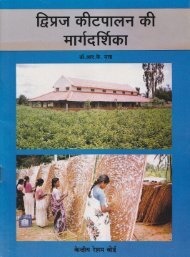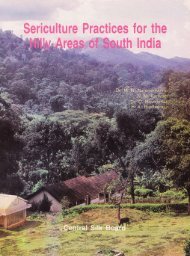E}A]\GALORE
Improved Method Rearing Younf Age (Young) Silkworms - Central ...
Improved Method Rearing Younf Age (Young) Silkworms - Central ...
- No tags were found...
You also want an ePaper? Increase the reach of your titles
YUMPU automatically turns print PDFs into web optimized ePapers that Google loves.
Thus, it is important to ensure that the bed humidity is kept between 80-90 per cent<br />
and for this, necessary manipulation, as indicated above, rs very essential. Otherwise,<br />
disease problems are bound to arise. lf the bed humidity is high-beyond g0 per cent,<br />
the worms will automatically become susceptible to Grassarie as well as Muscardine<br />
diseases. And, if the humidity falls below 80 per cent, the leaves will tend to dry fast,<br />
leading to undernourishment and the resultant weakening of worms, as indicated by<br />
slow growth and prolonged larval instar, inspite of optimum temperature conditions.<br />
The temperature of the room should be maintained at aboul 27"C by suitably<br />
manipulating the doors and windows of the room during different parts of the day and<br />
allowing better aeration of the room when the temperature and humidity go beyond the<br />
tolerance limit as indicated in Bulletin No. 2 of the lnstitute. When the temperature falls<br />
below 25'C, the rearing room should be artificially heated using an electric heater'or<br />
a smokeless charcoal fire inside the room sci as to bring up the temperature to the level<br />
ol 27"C.<br />
The maintenance bf humidity and temperature as indicated above willensure fast<br />
and vigorous growth of the worms uniformly.<br />
G. Spacing:<br />
ln the Bulletin No. 2 on the "New Technology of silkworm Rearing", the<br />
importance of optimum spacing of thb worms in rearing beds has been adequately<br />
stressed. This constitutes an essential technical consideration for successful harvest of<br />
bumper cocoon crops. This applies with greater emphasis to the rearing of young age<br />
silkworms. Through optimum spacing at every stage of rearing, starting from brushing<br />
of the worms, vigorous growth, robust health and uniform development of the entire<br />
batch of worms are ensured (as shown in Figure 4).<br />
Experimental studies in this regard have established that the optimum spacing<br />
for young age worms in their first two instars is as follows for 100 layings which contain<br />
an average of aOO eggs per laying:<br />
Age of the Area of the rearing bed lncrease in spacing<br />
worm At the beqinninq At the end<br />
the instar<br />
4 sq. ft<br />
15 sq. ft<br />
14 sq. ft<br />
45 sq. ft<br />
31/z times<br />
3 times<br />
ln actual practice where 3'x2'x3" trays are used for chawki rearing, as<br />
recommended earlier, it is convenient to rcar a certain number of eggs in one and the<br />
same tray till the second moult is passed. Therefore, 100 layings should be brushed<br />
in 10 trays at the rate of 10 layings per tray (measuring g,x2'x3,,). ln that case, the<br />
spacing to be adopted in each tray will be as described further.<br />
11


![E}A]\GALORE](https://img.yumpu.com/54052619/15/500x640/eagalore.jpg)

